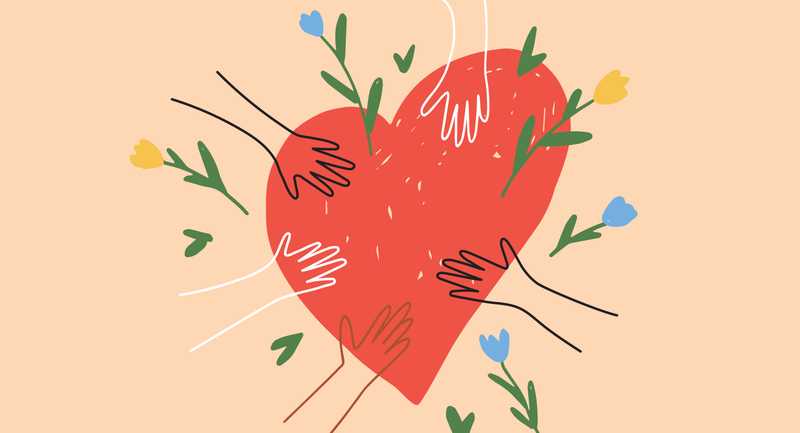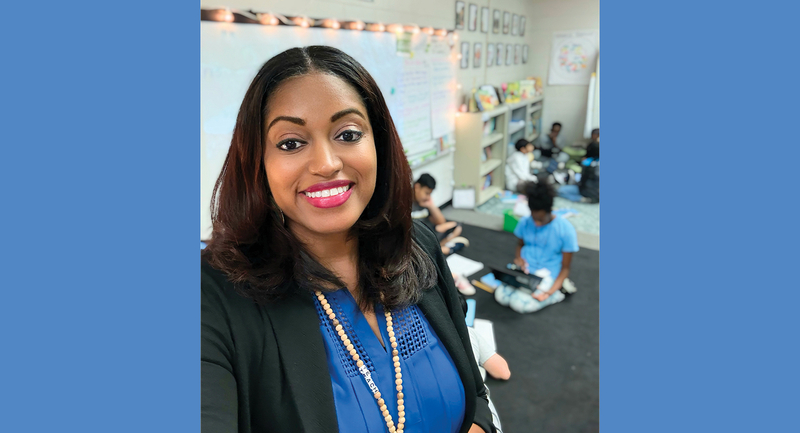Sowing Small Seeds of Kindness
The staff and students of the Milford Public School District have been focusing on building positive relationships. Over the course of the school year, we have introduced Seeds of Happiness as a way to build a positive school culture. Seeds of Happiness are small lumps of clay with endearing happy faces. Each seed comes with a 'Story' card explaining how a smile can make a difference in someone's life. At the high school, we made seeds available to all students and staff to give to someone. This simple gesture of giving a seed has fostered positive relationships among peers, colleagues, students, and teachers.
—Lucy Jenkins, director of special education, Milford Public School District, Milford, Massachusetts
It's Teacher Appreciation Day!
Our school principal invites several 8th grade students back over the summer to talk on video about a teacher in our school who changed their life. On the first day of school, all of the teachers meet in the media center and watch this video. It's really empowering to hear how even the smallest thing makes a difference in our students lives. Better yet, it's a great feeling when your colleagues are cheering you on as well. We start each school year with a renewed purpose and feel inspired to keep making a difference in the lives of our students.
—Andrea Coffey, library and media specialist, Samuel S. Yellin High School, Stratford, New Jersey
Celebrate Students and Staff
Our high school leadership students have made a few simple changes that really increased positive energy at the school. One was monthly birthday cakes, where one student per grade was selected to receive a birthday cake. The leadership students presented the cake to the student and his or her class and sang "Happy Birthday." Students who don't usually receive such public acknowledgement had a great day, the entire class enjoyed the celebration, and a positive and uplifting vibe was immediately created throughout the school. The leadership team also had the idea to acknowledge the school's support staff at assemblies. At one of the spirit assemblies, students presented a "golden keyboard" to the head secretary to acknowledge the hard work the office staff does.
—Pam Davidson, Director of Learning Services, Rocky View Schools, Alberta, Canada
The Power of Music
At Clarksburg High School in Maryland, I introduced 88 Keys. In our main atrium we added an upright standing piano for all to use. Before school, between classes, and after school, students can sit down and play a quick tune or chopsticks for all to enjoy. Taking an empty space and filling it with music that can be heard throughout the building has been a great positive motivator. Music can touch the soul in such a positive and powerful way.
—Edward Owusu, principal, Clarksburg High School, Clarksburg, Maryland
When Positivity Is a Civic Duty
North Broward Preparatory School placed a focus on citizenship at the personal, local, national, and global levels to infuse positive energy into its culture. The middle school used this theme to foster a culture of respect, accountability and leadership. Students were provided with the opportunity to gain an awareness of themselves and others, practice good decision making, take responsibility for their words and actions, and stand up against injustice. This focus on citizenship sparked a number of student-led initiatives such as Samaritan 365 Club, the completion of "I Am Me" videos, famous positive role model speakers for Leadership Day, and recognition as runner up for the Sandy Hook Promise "Student Spirit, Creativity, and Sustainability" award. Respect for self and others was at the heart of this movement.
—Genevieve Hoppe, middle school principal, North Broward Preparatory School, Coconut Creek, Florida
Switching Focus
We refocused our conversations and work around our moral purpose in education: What would we want for our own children or someone special in our life? This focus helped to ground our collaborative efforts to ensure high levels of learning for every child and has driven how we operate as an organization.
—Will Remmert, principal, New Prague Area Schools, New Prague, Minnesota
Allowing Time to Refocus and Recharge
Brooklyn College Academy, an early college prep high school in Brooklyn, New York, has established a mindfulness center. Located in a recently renovated room, the center is a multi-purpose "safe space" for mindfulness, social-emotional learning, and restorative community-building programs. BCA mainly serves low-income students of color who balance a rigorous curriculum, a competitive college admissions process, and myriad socio-economic and emotional challenges that can disrupt their forward movement. Students expressed the need for "decompression" and "resetting" strategies to sustain their achievements. Thus the center, designed to reduce student stress and build resilience and positivity.
The innovative and model center garnered much attention during the 2017 school year, from helping BCA become one of 15 schools nationwide to be selected as a finalist for the Farmers Insurance Dream Big Teacher Challenge contest, to being visited by NYC's First Lady Chirlane McCray. Students are currently using the center to practice mindfulness between classes. Additional programming is in development, and includes a unique feature: Students who will become mindfulness practitioners leading peers in meditative practices.
—Linda Noble, humanities teacher, Brooklyn College Academy, Brooklyn, New York
The Selfie Strategy
As two Massachusetts principals in a middle school and in a high school, we started taking selfies with students on Thursday mornings. We included signs in the photos, with messages such as "You Are Special" or "You Bring Joy." This simple gesture was a culture-builder at once. We post the photos on Twitter with the hash tag #PositiveSignThursday, and other principals, teachers, and central office supervisors from around Massachusetts and across the country have joined in. (https://youtu.be/coHyD-0zVJk)
—Martin Geoghegan, principal, John T. Nichols, Jr. Middle School, Middleborough, Massachusetts, and Brian McCann, principal, Joseph Case High School, Swansea, Massachusetts
The Magic and Power of "Yet"
Who knew that a simple three-letter word placed decidedly at the end of a sentence could pack such a punch? About five years ago, our school decided to implement standards-based grading. Our emphasis on true mastery enabled our learners to revise and resubmit, and our teachers to reteach and retest. We changed how we graded and what we reported to parents. The entire process was both messy and exhilarating! At the start of it, we did not have it all quite figured out—at least not yet.
Through the transition, it was impossible for our teachers not to embrace a growth mindset for our kids. It came with the territory. The relationship between the teachers and the kids underwent a fundamental shift. Teachers were no longer dispensers of grades, but learning coaches. We were no longer teaching students, we were engaging learners. One of our learners explained the difference this way, "Students wait for the teacher to tell them what to do and how to do it and learners want to figure it out for themselves."
—Donna Moss, principal, Cathedral School, Raleigh, North Carolina
Rewarding Great Behavior
This school year we opened our Moose Market. Students can earn Moose Bucks for going above and beyond, and then they can use those bucks to purchase fun items like a drone, gift cards to local businesses, school supplies, sports equipment, and t-shirts and socks from our school and the local university. Students now have a reason to do more than what is just expected. The positive shift has reduced absenteeism and decreased behavior issues.
—Eric Palmer, assistant principal, Alamosa School District, Alamosa, Colorado
Student-Led Design Thinking
Late last summer at Henry Ford Academy, new and incoming high school students, teachers, parents and others participated in activities to create connections and design a way to strengthen the culture across the school community. The students drove the process, working in multi-age teams of four. They build up their empathetic understanding through interviews and discovery; reframed the challenge based on needs and insights; came up with ideas, shared them, and gathered feedback; and generated new proposed solutions based on the feedback they received. The learning experience culminated in a pitch event, with teams presenting their creative solutions and business models for implementation. Students' prototypes included a coffee cart that could serve as a meeting spot for casual conversations and also generate monetary support for after-school programs, as well as a mindfulness room to help students center themselves and focus on school.
—Deborah Parizek, executive director, Henry Ford Learning Institute, Dearborn, Michigan
Messages of Support
Our social-emotional committee and clinical team devised a fun way to show our students that we care about them. Every staff member had students assigned to them, and on the day before winter break, we placed a caring message on each student's locker to surprise them.
—Brian Bullis, principal, Charles J. Caruso Middle School, Deerfield Public Schools District 109, Deerfield, Illinois






